Content
Kinetics: Impulse
Principle of
Impulse and Momentum
Momentum Change under a Constant Force
Momentum Change under a Varibale Force
Momentum Change of a System of Objects
Impulse Motion under an Impulsive Force
Kinetics: Impulse
Work is the study of the effect of a force along with the displacement of an object. Power is the study of the time rate of doing work. The time required to do work is also a constraint on studying the motion of an object. Impulse is another concept developed to study the effect of the motion of the object acting on another object over a time interval.
Principle of Impulse and Momentum
By Newton's Second Law, the acceleration of an object due to the force F acting upon an object is proportional to the magnitude of the force and the acceleration is in the direction of the force. Acceleration is defined as the rate of change of velocity. Since the mass of the object is constant, force can then be expressed in term of the rate of change of the product of mass and velocity. By definition of momentum, the product of mass and velocity is equal to the momentum of the object. In other words, the force F acting upon an object is equal to the rate of change of the momentum of the object.
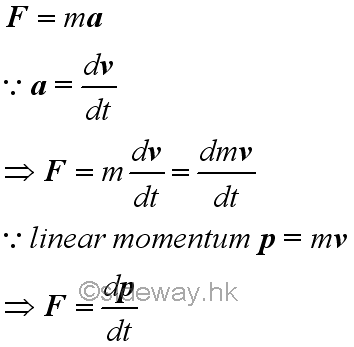
For the kinetic motion of the object, a concept of impulse is defined to quantify the change of kinetic motion of an object after a time interval which is expressed as the vector sum of the applied force acted upon the object over the time interval.
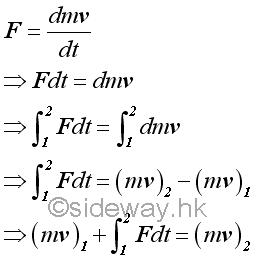
The integral of force with respect to time is a vector quantity call impulse or linear impulse. The linear impulse is therefore equal to the linear momentum change. Although in many applications, an impulse is usually refer to a constanct force acting over a small time interval, an impulse can be applied to any application by performing the integration of the integral of which the force can be a constant force or a function of time.

Since impulse is a vector quantity, the final momentum vector of an object is equal to the initial momentum vector of the object plus the impulse vector of the force during the time interval considered vectorially.

Similarly, the force vector can also be resolved into rectangular componebts,

Momentum Change under a Constant Force
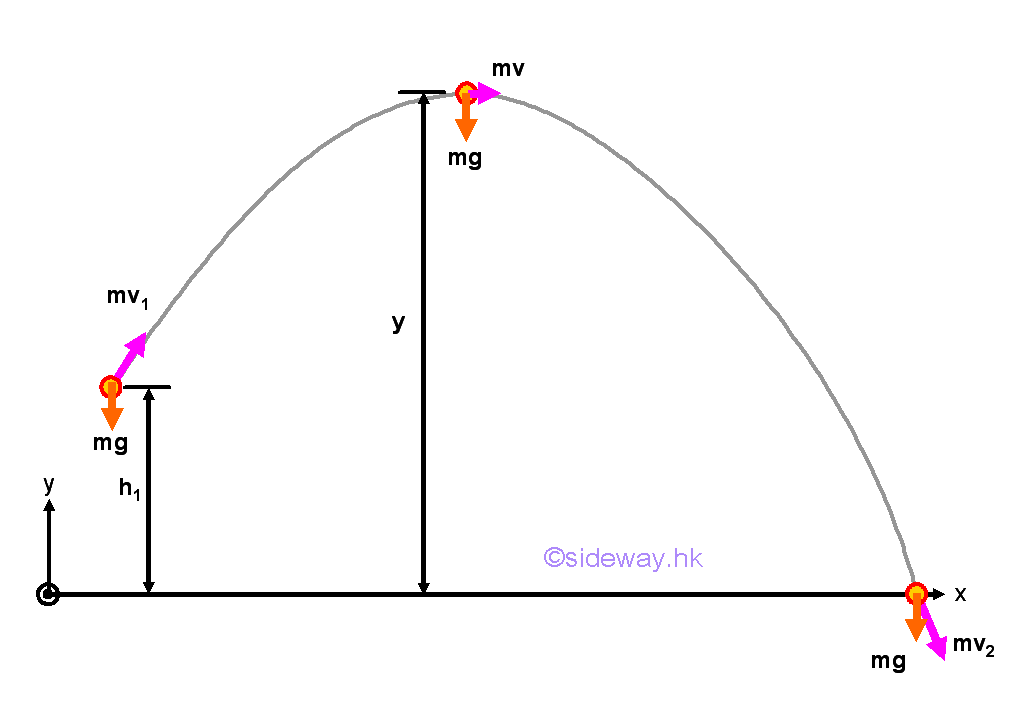
The nature of an impulse is just a force function acting on an object over a time interval. For example, a projectile of mass m projected from a level of height h1 with initial launch velocity v1 and initial launch angle θ under a constant force of gravity over a time interval, the momentum change of the projectile just before hitting the ground can also be determined by means of the principle of impulse and momentum if the time interval is known.
The x component of the momentum of the projectile remains unchanged.
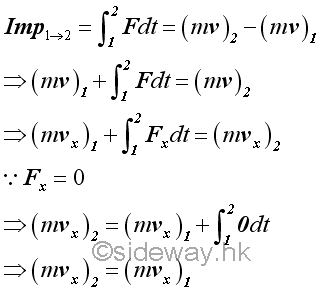
The y component of the momentum change of the projectile can be expressed in form of impulse and momentum change.
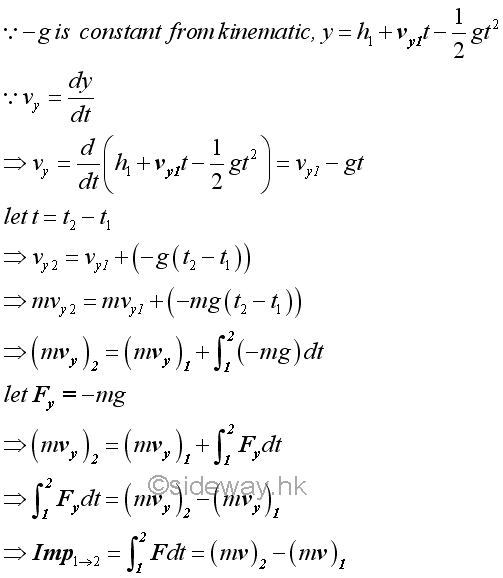
Therefore.
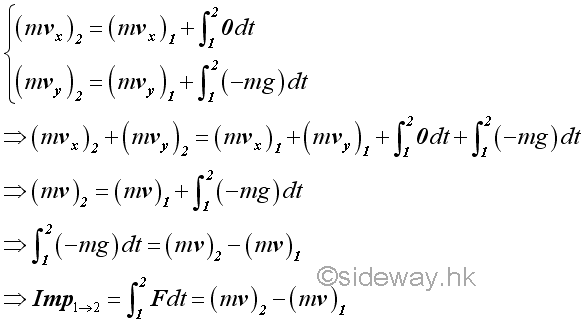
Momentum Change under a Varibale Force

In fact, an impulse can also a variable force function acting on an object over a time interval. For example, a horizontal circular motion of a mass m. the momentum change of the mass can also be determined by means of the principle of impulse and momentum.
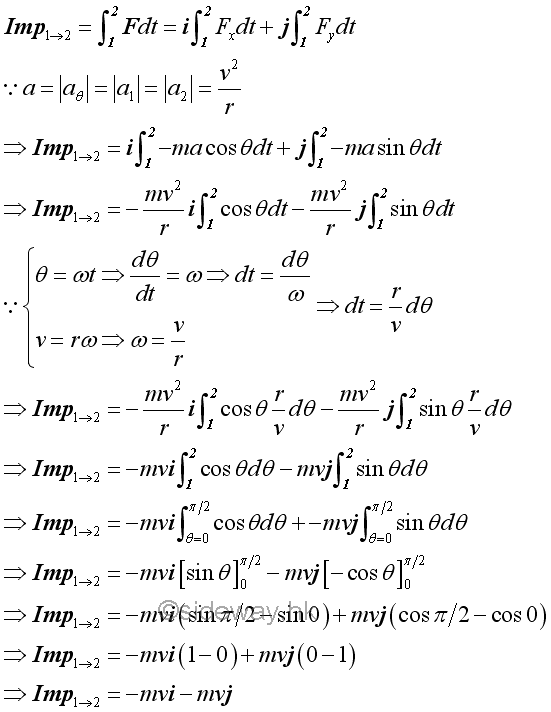
Therefore by the principle of impulse and momentum change, imply.
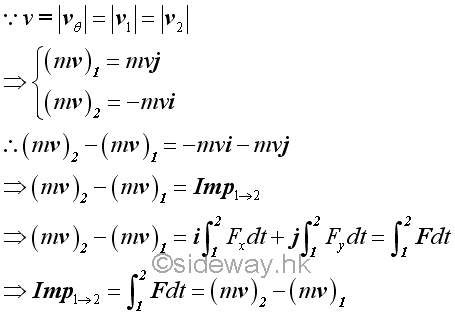
Momentum Change of a System of Objects
Similarly, the principle of impulse and momentum change can also be applied to a system of objects by considering each particle separately.
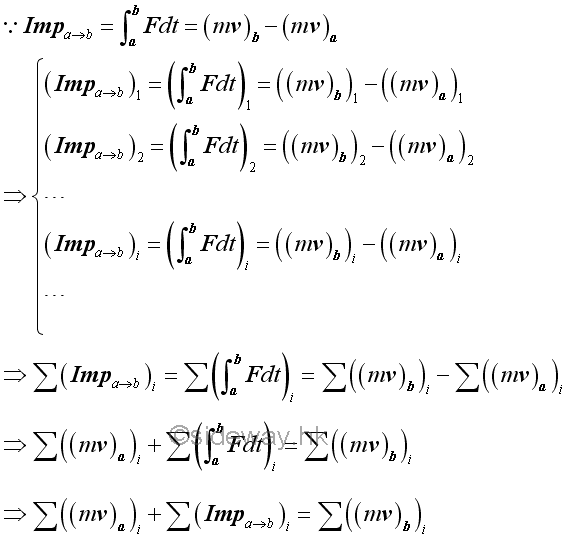
For example, two objects are connected by a spring and are held some distance apart. By neglecting the friction force, the momentum changes of two objects can be related by the principle of impulse and momentum change.
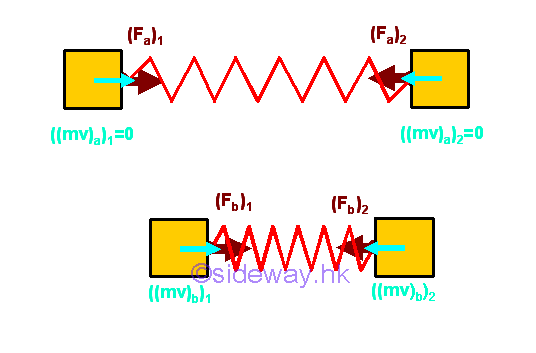
Since the spring forces acting on the two object are always equal in magnitude but opposite in direction, The momentum changes of the two objects can be related by the impulses acting on the two objects.
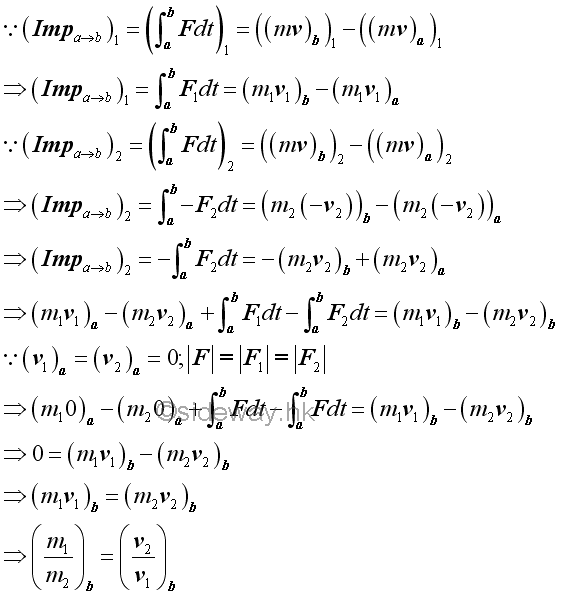
Since there is no external force acting on the system, and the internal forces, spring forces, acting upon the system of objects always form equal and opposite force pairs, the impulse acts on the system must be equal to zero. Therefore the total momentum of the system of objects must always be the same. In other words, the total momentum of the system of objects is conserved. For a two objects system, the velocities of the two objects are inversely proportional to the masses of the two objects.

Impulse Motion under an Impulsive Force
The concept of impulse usually focus on applications of applying a large force to an object over a very short time interval such that a definite momentum change of the object is produced. An impulsive force is therefore a force that can cause a definite momentum change over a very short time interval. And the resulting motion due to an impulsive force is called an impulsive motion. Comparing to an impulsive force, a non-impulsive force usually produces a gradually change in the momentum of the object. Force of gravity acting on a projectile, centripetal force acting on an object undergoing circular motion, or the spring forces acting on a spring connected objects are examples of non-impulsive forces. Since an impulsive force only acting on an object over a very short time interval, the resulting impulse is equal to the average value of the force exerting on the object during the short time interval.
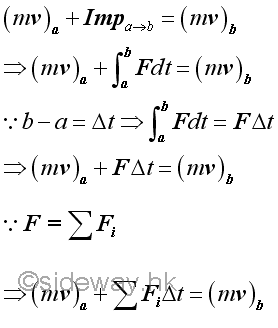
Since the impulsive action usually produces a much larger momentum change than that of the non-impulsive forces produce, the non-impulsive forces acting on an object can usually be neglected in the application of the principle of impulse and momentum.
Similarly, the impulsive motion can also be applied to a system of objects.
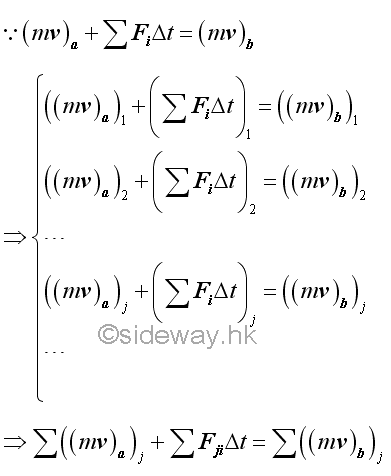
If there is no external impulsive force acting on the system of objects, and all external non-impulsive forces acting on the system of objects can be neglected. The equation of impulse and momentum can be reduced to equation of momentum terms only. Therefore the total momentum of the system of objects must always be the same. In other words, the total momentum of the system of objects is conserved.
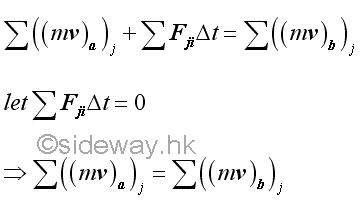
©sideway
ID: 141200003 Last Updated: 12/11/2014 Revision: 1 Ref:
References
- I.C. Jong; B.G. rogers, 1991, Engineering Mechanics: Statics and Dynamics
- F.P. Beer; E.R. Johnston,Jr.; E.R. Eisenberg, 2004, Vector Mechanics for Engineers: Statics
Latest Updated Links
- Panasonic SR-CK05 RiceCooker CW-HZ70AA(last updated On 11/17/2025)
- Panasonic Hood Structure Ventilating Fan Blade Diameter: 8in FV-20WH307 CW-HZ70AA(last updated On 11/16/2025)
- Panasonic Window Mount Thermo Ventilator FV-30BW2H CW-HZ70AA(last updated On 11/15/2025)
- Panasonic Inverter PRO Inverter Window Heatpump Air-Conditioner (3/4 HP) CW-HZ70AA(last updated On 11/14/2025)
- Panasonic Inverter Window-Split Type Cooling Only Air-Conditioner (1 HP) CS-U9YWA(last updated On 11/13/2025)
- Panasonic Inverter Steam and Grill_Microwave Oven 27L NN_DS59NB(last updated On 11/12/2025)
- Panasonic KY-C223B Induction Cooker(last updated On 11/11/2025)
- Focus M41 Single lever kitchen mixer 160(last updated On 11/10/2025)
- Focus Single lever basin mixer 230(last updated On 11/9/2025)
- Precision Start Thermostat shower mixer(last updated On 11/8/2025)
- Tempesta 100 Shower Rail Set 3 sprays(last updated On 11/7/2025)

 Nu Html Checker
Nu Html Checker  53
53  na
na  na
na
Home 5
Business
Management
HBR 3
Information
Recreation
Hobbies 8
Culture
Chinese 1097
English 339
Travel 18
Reference 79
Hardware 40
Computer
Hardware 259
Software
Application 213
Digitization 37
Latex 52
Manim 205
KB 1
Numeric 19
Programming
Web 289
Unicode 504
HTML 66
CSS 65
SVG 46
ASP.NET 270
OS 431
DeskTop 7
Python 72
Knowledge
Mathematics
Formulas 8
Set 1
Logic 1
Algebra 84
Number Theory 206
Trigonometry 31
Geometry 34
Calculus 67
Engineering
Tables 8
Mechanical
Rigid Bodies
Statics 92
Dynamics 37
Fluid 5
Control
Acoustics 19
Natural Sciences
Matter 1
Electric 27
Biology 1
